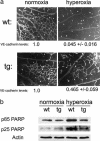Microvascular patterning is controlled by fine-tuning the Akt signal
- PMID: 15611473
- PMCID: PMC538747
- DOI: 10.1073/pnas.0403198102
Microvascular patterning is controlled by fine-tuning the Akt signal
Abstract
We investigated the functions of Akt during vascular development and remodeling by using an inducible endothelial cell-specific driver of the dominant-active myrAkt. We found that sustained signaling in response to overexpression of myrAkt led to embryonic lethality, edema, and vascular malformations. In addition to the morphological malformations, the vascular phenotype was consistent with a failure in remodeling, such that the normal patterning and vessel hierarchy was disturbed. Examination of the well studied retinal vasculature during the remodeling phases revealed that transient expression of myrAkt was capable of altering the normal response to oxygen-induced remodeling without causing vascular malformations. These findings suggest that physiological levels of Akt signaling modulated microvascular remodeling and support the hypothesis that, although Akt may be required for vascular growth and homeostasis, appropriate down-regulation is also an essential aspect of normal vascular patterning.
Figures




References
-
- Dimmeler, S. & Zeiher, A. M. (2000) Circ. Res. 87, 434-439. - PubMed
-
- Liu, W., Ahmad, S. A., Reinmuth, N., Shaheen, R. M., Jung, Y. D., Fan, F. & Ellis, L. M. (2000) Apoptosis 5, 323-328. - PubMed
-
- Provis, J. M., Leech, J., Diaz, C. M., Penfold, P. L., Stone, J. & Keshet, E. (1997) Exp. Eye Res. 65, 555-568. - PubMed
-
- Pe'er, J., Shweiki, D., Itin, A., Hemo, I., Gnessin, H. & Keshet, E. (1995) Lab. Invest. 72, 638-645. - PubMed
Publication types
MeSH terms
Substances
Grants and funding
LinkOut - more resources
Full Text Sources
Other Literature Sources
Molecular Biology Databases

